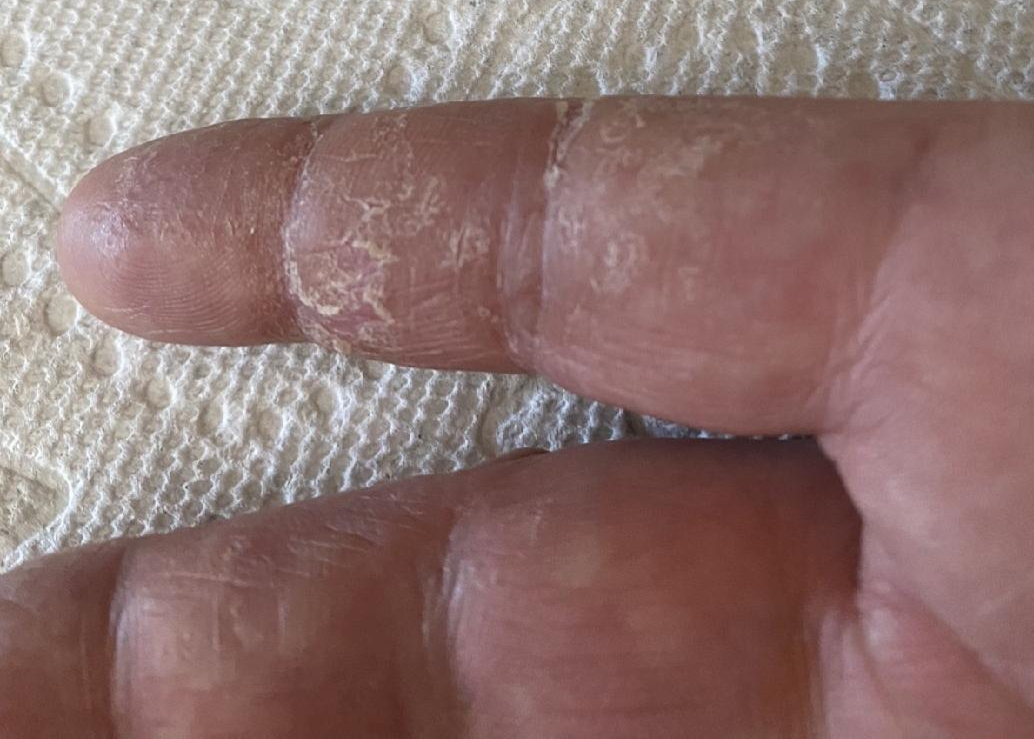Previous Issues Volume 8, Issue 4 - 2023
Case Report: Nosocomial Digital Eczema from Surface Cleansing Bleach
James Espinosa1,*, Umar Sannoh2, Alan Lucerna3, Joseph Pagano1
1Department of Emergency Medicine, Jefferson Health, NJ - Stratford, NJ, USA
2Rowan-Virtua, SOM, Medical School, Stratford, NJ, USA
3Program Director, Emergency Medicine Residency, Jefferson Health New Jersey, Stratford, NJ, USA
*Corresponding Author: James Espinosa MD, Department of Emergency Medicine, Rowan University SOM Kennedy University Hospital, 18 East Laurel Road, Stratford, NJ 08084, USA; Email: [email protected]
Received Date: June 28, 2023
Publication Date: July 13, 2023
Citation: Espinosa J, Sannoh U, Lucerna A, Pagano J. (2023). Case Report: Nosocomial Digital Eczema from Surface Cleansing Bleach. Mathews J Emergency Med. 8(4):64.
Copyright: Espinosa J, et al. © (2023)
ABSTRACT
We report the case of a healthcare provider who developed hand eczema, predominantly on the first digit and thumb of the right hand, in association with contact with the surface of a desk and contact with a computer mouse at work. The eczema abated on days off and was exacerbated within hours of work. The diagnosis was made of hand eczema from surface cleaning bleach. It was noted that several other healthcare providers had developed similar symptoms. The patient's eczema was confirmed by a dermatologist and was successfully treated with topical triamcinolone and emollient cream to the affected areas. Prevention by adhesive strip band aids to the affected areas of the hand as well as water cleansing to previously bleach-cleansed surfaces has been helpful.
Keywords: Nosocomial digital eczema, digital eczema, eczema from surface cleaning bleach
CASE PRESENTATION
We report the case of a healthcare provider who developed hand eczema, predominantly on the first digit and thumb of the right hand, in association with contact with a desk and mouse pad at work. The healthcare worker used soap and water cleansing of the hands and so hand sanitizer exposure was not an issue. The eczema abated on days off and was exacerbated within hours of work. The diagnosis was made of hand eczema from surface cleaning bleach. It was noted that several other healthcare providers had developed similar symptoms. The patient's eczema was treated with topical triamcinolone and emollient cream to the affected areas for several hours at night using a non-vinyl glove. Prevention included wiping the desk area, mouse and keyboard with water-soaked pads prior to use.
Figure 1: Affected area of hand.
DISCUSSION
The case presented represents an example of an occupationally-related dermatological condition from chemical exposures.
According to Anderson, there are three types of occupationally related chemical skin exposures: [1]
- Direct skin effect
- Immune mediated effect
- Systemic effects
Surface cleaning bleach has been described as a direct skin effect exposure occupational irritant [1]. Another direct skin exposure agent that has been described as related to hand eczema in some healthcare workers is hand sanitizer [2,3]. In the case presented, the healthcare worker used soap and water cleansing of the hands.
Hand eczema of all types has been on the increase world-wide since late 2019, with the suggestion that this may be related to COVID-19 due to an associated increased use of strong surface cleansers as well as increased use of hand sanitizer [4-7].
Treatment includes standard eczema cream, moisturizer and reduction of contact with the surface bleach [8].
CONCLUSION
Hand eczema of all types has been on the increase world-wide since late 2019, with the suggestion that this may be related to COVID-19 due to an associated increased use of strong surface cleansers as well as increased use of hand sanitizer. Here we report the case of a healthcare provider who developed hand eczema, predominantly on the first digit and thumb of the right hand, in association with contact with a desk surface and use of a computer mouse at work. The healthcare worker used soap and water cleansing of the hands and so hand sanitizer exposure was not an issue. The eczema abated on days off and was exacerbated within hours of work. The diagnosis was made of hand eczema from surface cleaning bleach. It was noted that several other healthcare providers had developed similar symptoms. The patient's eczema was treated with topical triamcinolone and emollient cream to the affected areas for several hours at night using a non-vinyl glove. Prevention included wiping the desk area, mouse and keyboard with water-soaked pads prior to use.
CONFLICTS OF INTEREST
The authors declare that they have no conflicts of interest.
REFERENCES
- Anderson SE, Meade BJ. (2014). Potential health effects associated with dermal exposure to occupational chemicals. Environ Health Insights. 8:51-62.
- Batalla A, García-Doval I, de la Torre C. (2012). Products for hand hygiene and antisepsis: use by health professionals and relationship with hand eczema. Actas Dermosifiliogr. 103(3):192-197.
- Larson E, Girard R, Pessoa-Silva CL, Boyce J, Donaldson L, Pittet D. (2006). Skin reactions related to hand hygiene and selection of hand hygiene products. Am J Infect Control. 34(10):627-635.
- Erdem Y, Altunay IK, Aksu Çerman A, Inal S, Ugurer E, Sivaz O, et al. (). The risk of hand eczema in healthcare workers during the COVID-19 pandemic: Do we need specific attention or prevention strategies? Contact Dermatitis. 83(5):422-423.
- Guertler A, Moellhoff N, Schenck TL, Hagen CS, Kendziora B, Giunta RE, et al. (2020). Onset of occupational hand eczema among healthcare workers during the SARS-CoV-2 pandemic: Comparing a single surgical site with a COVID-19 intensive care unit. Contact Dermatitis. 83(2):108-114.
- Huang D, Tang Z, Qiu X, Liu X, Guo Z, Yang B, et al. (2020). Hand eczema among healthcare workers in Guangzhou City: a cross-sectional study. Ann Transl Med. 8(24):1664.
- van der Meer EW, Boot CR, van der Gulden JW, Jungbauer FH, Coenraads PJ, Anema JR. (2013). Hand eczema among healthcare professionals in the Netherlands: prevalence, absenteeism, and presenteeism. Contact Dermatitis. 69(3):164-171.
- Agner T, Elsner P. (2020). Hand eczema: epidemiology, prognosis and prevention. J Eur Acad Dermatol Venereol. 34(1):4-12.
